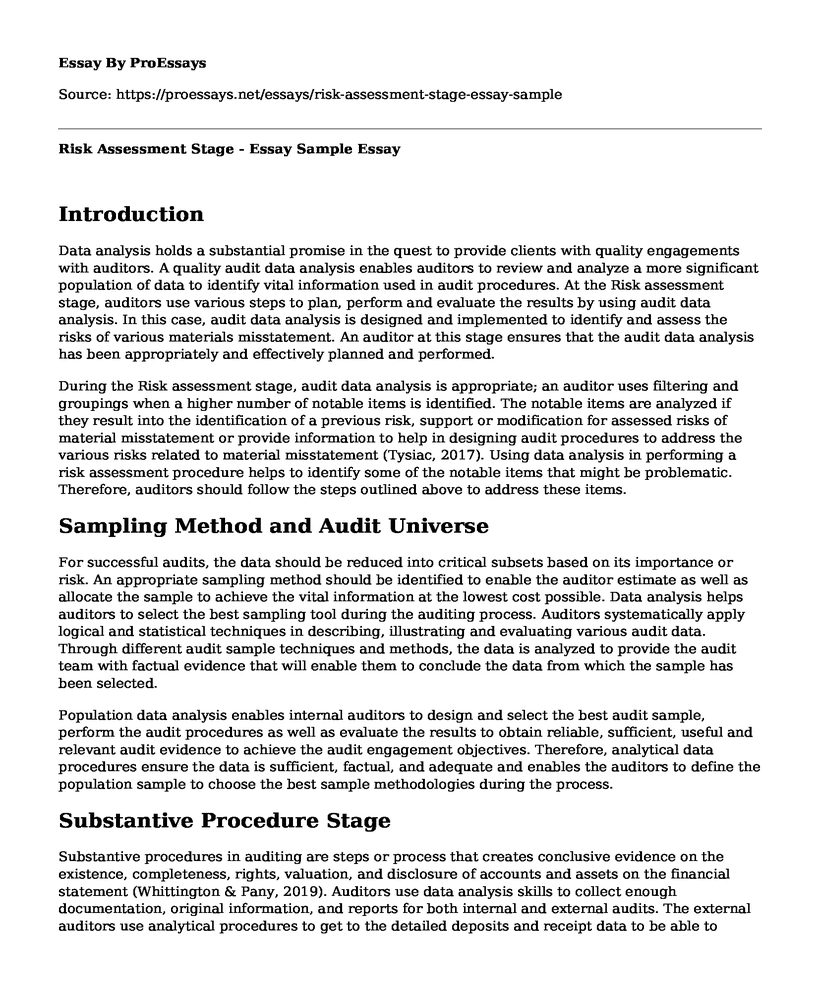Introduction
Data analysis holds a substantial promise in the quest to provide clients with quality engagements with auditors. A quality audit data analysis enables auditors to review and analyze a more significant population of data to identify vital information used in audit procedures. At the Risk assessment stage, auditors use various steps to plan, perform and evaluate the results by using audit data analysis. In this case, audit data analysis is designed and implemented to identify and assess the risks of various materials misstatement. An auditor at this stage ensures that the audit data analysis has been appropriately and effectively planned and performed.
During the Risk assessment stage, audit data analysis is appropriate; an auditor uses filtering and groupings when a higher number of notable items is identified. The notable items are analyzed if they result into the identification of a previous risk, support or modification for assessed risks of material misstatement or provide information to help in designing audit procedures to address the various risks related to material misstatement (Tysiac, 2017). Using data analysis in performing a risk assessment procedure helps to identify some of the notable items that might be problematic. Therefore, auditors should follow the steps outlined above to address these items.
Sampling Method and Audit Universe
For successful audits, the data should be reduced into critical subsets based on its importance or risk. An appropriate sampling method should be identified to enable the auditor estimate as well as allocate the sample to achieve the vital information at the lowest cost possible. Data analysis helps auditors to select the best sampling tool during the auditing process. Auditors systematically apply logical and statistical techniques in describing, illustrating and evaluating various audit data. Through different audit sample techniques and methods, the data is analyzed to provide the audit team with factual evidence that will enable them to conclude the data from which the sample has been selected.
Population data analysis enables internal auditors to design and select the best audit sample, perform the audit procedures as well as evaluate the results to obtain reliable, sufficient, useful and relevant audit evidence to achieve the audit engagement objectives. Therefore, analytical data procedures ensure the data is sufficient, factual, and adequate and enables the auditors to define the population sample to choose the best sample methodologies during the process.
Substantive Procedure Stage
Substantive procedures in auditing are steps or process that creates conclusive evidence on the existence, completeness, rights, valuation, and disclosure of accounts and assets on the financial statement (Whittington & Pany, 2019). Auditors use data analysis skills to collect enough documentation, original information, and reports for both internal and external audits. The external auditors use analytical procedures to get to the detailed deposits and receipt data to be able to reconcile both until every bit of the cash in the original receipt is accounted for. Using data analysis skills through the substantive procedures and auditor develops an independent expectation, defines the differences, computing the differences investigate their significance and draw their conclusions.
It is mandatory for the auditors to perform analytical procedures to assess whether the financial statements are correct and consistent with their understanding of the entity. Substantive analytical procedures apply to larger volumes of transactions that can be predictable over time. Analytical procedures can help to provide evidence for assertions, direct auditors attention for further investigation and identifying audit issues that will not be apparent in more detailed work (Acca, n.d.).
End of Audit
The main purpose of using analytical procedures in auditing is to ensure the planning is systematic and helps to obtain specific evidence about the account balances or transactions. At the end of the audit, the final analytical review is done to do an overall review of the various financial statements (Acca, n.d.). This is to assess whether they are consistent with the understanding of the entity by the external or internal auditor. Data analytic procedures at the end of the audit, review the evidence and sufficiency of the audit obtained and propose actions either for further audits or documentation. At final data analytic review of the audit the audited work is reviewed on who did it the date and to which extent. Moreover, there is an evaluation of various misstatements noticed or identified during the audit. All the misstatements are identified and further audit procedures recommended for the adjustment of the financial statements.
References
Acca. (n.d.). Analytical procedures. Retrieved from https://www.accaglobal.com/vn/en/student/exam-support-resources/professional-exams-study-resources/p7/technical-articles/analytical-procedures.html
Tysiac, K. (2017). Using audit data analytics in performing a risk assessment procedure. Retrieved from https://www.journalofaccountancy.com/news/2017/dec/using-audit-data-analytics-for-risk-assessment-201717981.html
Whittington, R., & Pany, K. (2019). Principles of Auditing and Other Assurance Services. New York: McGraw-Hill Education.
Cite this page
Risk Assessment Stage - Essay Sample. (2022, Dec 12). Retrieved from https://proessays.net/essays/risk-assessment-stage-essay-sample
If you are the original author of this essay and no longer wish to have it published on the ProEssays website, please click below to request its removal:
- Insurance Essay Sample: Moral Hazard
- Issue Analysis Paper Example: School Funding
- Essay Sample on Universal Taxation in Education: A Necessity for All
- Calculating Return on Security Investment (ROSI) - Essay Sample
- Essay Example on Who Owns a Child? Exploring the Debate on Paternity Fraud Laws
- Paper Example on Turnaround: Nissan Improves Efficiency, HR & Adaptation
- Report Example on International Business: Intangible Assets & Cost







